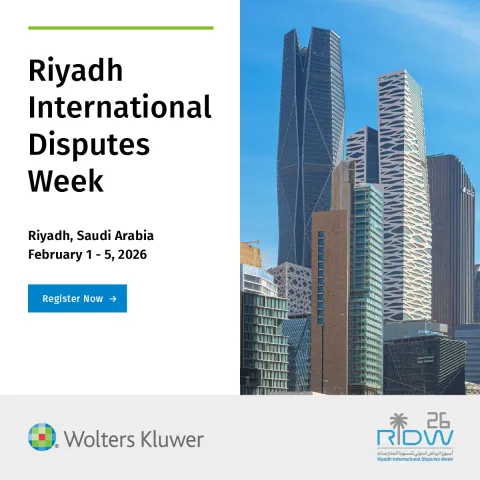Revisiting the Arb-Med-Arb Proceedings: Lessons from Swiss Court Rooms
July 21, 2025
In his 'Notes for a Law Lecture', Abraham Lincoln stated, "Discourage litigation. Persuade your neighbors to compromise whenever you can." While this quote dates back to the 1850s, it echoes recent dispute settlement trends.
Although complex disputes are typically resolved through litigation or arbitration, parties have increasingly sought to settle their disputes through less adversarial means or methods, combining arbitration and alternative dispute resolution (ADR). The Queen Mary University of London 2021 International Arbitration Survey, conducted among arbitration practitioners, confirmed this trend, as users found that 90% of interviewees indicated that arbitration was their preferred forum for resolving cross-border disputes, but 59% of them favored arbitration in conjunction with ADR, including mediation.
Various methods have emerged, including hybrid versions of common ADR means, such as "arbitration-mediation-arbitration" (Arb-Med-Arb) proceedings. Leading institutions, including the Singapore International Arbitration Centre (SIAC) and the Singapore International Mediation Centre ("SIMC"), now promote Arb-Med-Arb proceedings to settle disputes.
This trend has been foreshadowed by some Swiss courts for decades. In some German-speaking cantons, notably Zurich and Bern, the courts conduct a so-called Referentenaudienz, or Settlement Hearing, to resolve disputes early in the proceedings without a full trial. In this article, the authors will compare the Arb-Med-Arb protocol and the Swiss practice to conduct Settlement Hearings and elaborate on what arbitration practitioners may learn from the Swiss court rooms.
The Arb-Med-Arb Protocol
Arb-Med-Arb proceedings are initiated as arbitration. However, at an early stage, the arbitral process is stayed in favor of a window for mediation. In the absence of an Arb-Med-Arb clause, parties are also free to stay the arbitration proceedings to mediate. However, once the parties are already in dispute, it may prove difficult to jointly agree on mediation. Parties wishing for Arb-Med-Arb proceedings would, therefore, be well advised to introduce an Arb-Med-Arb clause in their contracts before a dispute emerges.
Leading institutions have embraced the trend and offer different hybrid methods of dispute resolution, as well as template clauses. Amongst them, SIAC and SIMC stand out. In 2014, SIAC and SIMC introduced a set of rules on Arb-Med-Arb proceedings (Protocol) and a template clause. Under the Protocol, a party initiates the proceedings by filing its notice of arbitration with SIAC. Following the response to the notice of arbitration, the arbitral proceedings are stayed, and the case is submitted for mediation to the SIMC. In contrast to the traditional understanding of the arb-med process in Asia, where the same person typically handles both arbitration and mediation, the Protocol takes a different stance. It assigns separate and independent appointments for arbitrators and mediators, with SIAC appointing the arbitrator(s) and SIMC appointing the mediator(s).
Where the parties successfully conduct the mediation and settle their dispute, the terms of their settlement agreement are recorded in a consent award. By contrast, if the parties cannot find an amicable solution to their dispute, the arbitration proceedings fully resume.
Notwithstanding the above, Arb-Med-Arb proceedings come with their challenges. One question that has spilled a lot of ink is whether the arbitrator and mediator acting during the Arb-Med-Arb proceedings ought to be the same person. Having the same person can lead to efficiencies and cost savings, but it also has its drawbacks. During the mediation window, the mediator may receive confidential information from a party, which the other party would not be privy to and has no opportunity to challenge. If mediation fails and the mediator starts acting under their capacity as an arbitrator, they might be influenced by information they would not have received if the mediator had been a different person. This is why, under the Protocol for instance, the mediator is independent from the arbitrator, unless the parties agree otherwise.
Settlement Hearings in Swiss Courts
In principle, Swiss state court litigation is governed by uniform procedural rules under the Swiss Civil Procedure Code (CPC). The CPC allows for local practices of the cantons, which leads to the possibility of conducting a Settlement Hearing in some courts. In use for decades, this practice is particularly applied by so-called commercial courts, i.e., courts focused on commercial disputes between companies, such as the Commercial Court of the Canton of Zurich (Commercial Court).
The proceedings are initiated by the plaintiff filing a full-fledged statement of claim. The court then proceeds with the exchange of the first round of written briefs on the substance. After the first round of written submissions has been concluded, the court invites the parties to an oral Settlement Hearing in the court. The Settlement Hearing lasts for several hours to a full day. There are no separate submissions in relation to the Settlement Hearing and no formal oral submissions by the parties. Rather, it is very informal in nature and the court does not take minutes on the positions that parties share during the settlement discussions.
Only a selection of the full adjudicating body of five judges attends the Settlement Hearing, typically comprising a judge from the Commercial Court and a judge with specific industry expertise. When the parties are represented by lawyers, they often attend the Settlement Hearing as well. However, the parties are free to abstain from involving lawyers.
Usually, the Settlement Hearing consists of three phases, but the court enjoys broad discretion. In the first phase, the judges ask whether the parties wish to hear their preliminary assessment of the case based on the first round of written submissions. If so, the judges share their assessment of the facts and the law. In many cases, the judges specifically comment on the chances of success of the claim(s). While this assessment only reflects the view of two judges and not the entire adjudicating body, it allows the parties to gain an early understanding of the strengths and weaknesses of their respective positions. In the second phase, the same two judges orally outline the pillars of a potential settlement framework that they deem reasonable based on their preliminary assessment. In the third phase, the judges facilitate discussions between the parties and tailor the settlement proposal to the parties' needs. The judges may also speak to each party individually while the other party is not in the court room.
Once the parties agree on the terms of the settlement, the judges assist in drafting the written settlement agreement. If an entity still must obtain consent or needs more time to think the deal through, the settlement agreement may sometimes provide for subsequent confirmation (Genehmigungsvorbehalt) or a deadline by when the parties can reject the deal (Widerrufsvorbehalt).
If the parties are unable to settle their dispute, the court proceedings continue. The court will invite the parties to submit their written briefs for the second round of submissions, which will usually be followed by a formal hearing on the substance. In these proceedings, the two judges who attended the Settlement Hearing will continue to act as judges, but they are precluded from relying on the information obtained during the Settlement Hearing.
The practice of Settlement Hearings has been widely successful. Although no official statistics have been published, experienced practitioners estimate the settlement rate to be between 60% and 75%.The high success rate underscores the effectiveness of the process in resolving disputes at an early stage, saving both time and costs for the subsequent litigation. In addition, it contributes to reducing the courts' backlog.
Main Differences between the Swiss Settlement Hearing and the Arb-Med-Arb Protocol
While both the Settlement Hearing and mediation under the Arb-Med-Arb Protocol serve to facilitate dispute resolution, they differ in several key aspects.
One of the most notable distinctions lies in the role of the adjudicators. In the Settlement Hearing, the judges who conduct the settlement discussions continue to serve as adjudicators if the parties fail to settle their dispute. This raises concerns regarding confidentiality and impartiality, as these judges gain (informal) insights into the parties' positions and their willingness to concede on certain points. Additionally, because the judges formally belong to the court, they may psychologically exert more pressure on the parties compared to a mediator.
By contrast, the Arb-Med-Arb Protocol ensures a strict separation between the roles of the arbitrator and the mediator. For instance, under the Protocol, SIAC appoints the arbitrator, while SIMC appoints the mediator, preventing any crossover of roles. This separation is designed to safeguard procedural fairness and avoid any risk of an arbitrator being influenced by confidential information disclosed during the mediation phase.
Another key difference is the approach to settlement discussions. The Swiss Settlement Hearing is largely driven by the judges' preliminary case assessment, giving the parties an early indication of their chances of success. This assessment often serves as a powerful tool in guiding the settlement negotiations. However, mediation under the Arb-Med-Arb Protocol is more focused on the parties' underlying interests and encourages solutions beyond strict legal arguments.
Finally, enforceability remains a crucial factor when comparing the two systems. In Swiss courts, settlement agreements are generally considered binding contracts and can be enforced as a "normal" contract. However, they do not enjoy any privileges under international conventions. The situation is different in the context of mediation. While the Singapore Mediation Convention provides a framework for international enforcement of mediated settlements, its limited number of signatories may present challenges in many jurisdictions. By contrast, the Arb-Med-Arb Protocol offers a particularly compelling advantage: settlements reached through mediation can be converted into consent awards, which are enforceable under the New York Convention.
Even in cases where a settlement is not reached, the Settlement Hearing may offer a distinct advantage that mediation is unable to provide. The Settlement Hearing, particularly the case assessment, provides parties with a clearer understanding of their key strengths and weaknesses, allowing them to refine their litigation strategy. Weak or untenable arguments can be eliminated early, leading to more efficient litigation.
What can the Arb-Med-Arb Protocol learn from the Swiss Settlement Hearing?
Despite their structural differences, the Swiss Settlement Hearing and the Arb-Med-Arb Protocol share a fundamental similarity: both afford parties a chance to settle the dispute under the guidance of a neutral third party. This creates opportunities for each system to draw inspiration from the other.
One potential lesson for the Arb-Med-Arb Protocol is the value of an early case assessment. In Swiss courts, the judges' preliminary case assessment provides parties with a clearer perspective on their positions, which helps frame their negotiation strategy. A similar case assessment in Arb-Med-Arb proceedings – perhaps a right of the mediator to issue an optional non-binding case assessment – could increase the perceived value of the mediation phase.
Another important aspect is the psychological and cultural impact of structured settlement procedures. In Switzerland, the longstanding practice of Settlement Hearings has contributed to a legal culture in which both, judges and parties actively engage in finding a solution. While arbitration practitioners may not have the same background, increasing familiarity with mediation – especially in regions like Asia, where mediation is gaining traction – could encourage greater acceptance and integration of Arb-Med-Arb procedures in international dispute resolution. In other words, if counsel and parties frequently see the beneficial outcomes from Arb-Med-Arb proceedings, they may opt for the Protocol more often in the future.
Lastly, the automatic application of Settlement Hearings in commercial disputes in Switzerland is likely another factor contributing to their success. However, implementing a similar mandatory step in arbitration poses challenges due to the principle of party autonomy, which allows parties to structure proceedings as they see fit. Nevertheless, integrating such a mechanism into more standardized arbitration frameworks – such as an investor-state dispute settlement (ISDS) or sports arbitration – could be a viable approach.
Conclusion: The Success of Swiss Settlement Hearings could foster the Success of the Arb-Med-Arb Protocol
The Settlement Hearing is a valuable tool for parties involved in Swiss court litigation, particularly in the Commercial Courts of Zurich or Bern. The high settlement rates testify to its success, and even when a settlement is not reached, the process provides valuable insights that can guide the parties' strategies in further proceedings.
The Settlement Hearing offers insights that could enhance the Arb-Med-Arb Protocol. First, an early case assessment by judges helps parties refine their arguments and can facilitate a settlement. Second, the more counsel and parties see the beneficial outcomes of mediation, they may be increasingly willing to include the Protocol in the future. Finally, the automatic application of Settlement Hearings in Swiss commercial disputes contributes to their effectiveness. While arbitration relies on party autonomy, integrating mandatory mediation into more standardized arbitration frameworks – such as ISDS or sports arbitration – could promote earlier settlements.
You may also like










Paul Sills
Editorial Comment: Hybrid Pathways – The Future of Dispute Resolution? Caroline Dos Santos and Janine Haesler’s thoughtful comparative piece invites us to reflect on the evolution of hybrid dispute resolution mechanisms, particularly the Arb-Med-Arb model promoted by institutions like SIAC and SIMC, and its parallels with long-standing practices in Swiss commercial courts. What emerges is a compelling case for structured yet flexible pathways to resolution—mechanisms that offer both procedural certainty and space for tailored solutions. The juxtaposition of the Arb-Med-Arb Protocol with the Swiss Settlement Hearing tradition shines a light on both the strengths and the limits of formal hybrid models. On the one hand, the Arb-Med-Arb framework, with its institutional safeguards and enforceability via consent awards under the New York Convention, addresses critical concerns of neutrality and cross-border efficacy. On the other, the Swiss courts’ informal, judge-led early case assessments demonstrate how candid judicial input and cultural familiarity with settlement can yield strikingly high resolution rates—without the need for procedural complexity. This raises a wider question for the dispute resolution community: Is it better to rely on formal, well-defined hybrid processes—or to develop more dynamic, adaptive models that draw from multiple traditions and practices to suit the dispute at hand? In a world where the contours of conflict are increasingly varied and international, perhaps the future lies not in standardisation, but in deliberate pluralism—choosing and adapting elements from different systems to create bespoke resolution journeys. We invite our readers—practitioners, counsel, arbitrators, mediators, and institutional designers—to share your own experiences of med-arb, arb-med-arb, or other hybrid procedures. What has worked? What challenges have emerged in practice, particularly regarding role separation, party buy-in, or enforceability? Have you seen success with more informal, culture-specific processes like those in Zurich or Bern? Your insights can help enrich the global dialogue about how best to combine the strengths of different dispute resolution methodologies. Whether through structured protocols or creative, case-specific hybrids, the goal remains the same: a fair, effective, and party-centred path to resolution.
Jeremy Lack
A Valuable Comparison, but Important Distinctions Remain Thank you to the authors for this thoughtful and well-structured comparative analysis. It is encouraging to see increased engagement with hybrid dispute resolution mechanisms and cross-jurisdictional insights. That said, I would respectfully suggest a word of caution about drawing direct parallels between the Arb-Med-Arb framework as developed under the SIAC/SIMC Protocol and the Settlement Hearings or conciliation procedures practiced in Swiss courts. While both aim to foster early settlement, they are rooted in fundamentally different procedural and conceptual traditions. In particular, it is important not to conflate mediation (a form of facilitated negotiation) with conciliation under Swiss law (a form of non-binding assessment or adjudication). These are distinct processes governed by separate parts of the Swiss Code of Civil Procedure, administered by different institutions and guided by very different philosophies. In Switzerland, conciliators are typically sitting judges appointed by a judicial authority (instance de conciliation), and their mandate is often limited in scope and time. Their approach tends to focus on legal positions and a preliminary judicial assessment of the facts and applicable law. It is not uncommon for them to propose settlement terms based on this analysis. By contrast, mediation — particularly as contemplated in the Singaporean Arb-Med-Arb model — is a facilitative and party-driven process. Mediators are appointed by the parties themselves (even if SIAC may be invoked in the nominations process), and their role is not to provide a legal assessment but to support the parties in exploring and safely exchanging information regarding their underlying needs, interests, concerns and motives — often well beyond the scope of legal pleadings. This distinction also underscores the difference between Swiss Litigation-Conciliation-Litigation (Lit-Con-Lit) and Arbitration-Mediation-Arbitration (Arb-Med-Arb). Without a conscious and deliberate choice by parties to opt out of conciliation and into mediation (which remains quite rare in Swiss practice), the two systems remain conceptually and functionally different in Switzerland. Certainly, there is much to be learned from the respective strengths of these approaches. A combination of mediation and conciliation, for example, is seldom considered but leads to much higher settlement rates and outcome satisfaction ratings. However, a true comparative analysis must take care to ensure that we are comparing apples to apples — particularly where the legal foundations and procedural objectives diverge so significantly. I greatly appreciate this contribution to the dialogue and look forward to continued discussion on how diverse traditions can inform each other without erasing important distinctions. I also invite a discussion on how mediation and conciliation could be better combined, rather than treated as alternatives to one-another, as is the case in many civil law jurisdictions.
Paul Sills
Editorial Comment: Mediation, Conciliation and Cultural Context — Are We Always Speaking the Same Language? The thoughtful comment posted in response to “Revisiting the Arb-Med-Arb Proceedings” offers a timely reminder: in comparative dispute resolution, precision in terminology is not just a matter of academic neatness—it is critical to legal and procedural clarity. The distinction drawn between Swiss court procedures and facilitative mediation under the SIAC/SIMC Arb-Med-Arb Protocol highlights a recurring challenge in the global discourse on hybrid and multi-tiered dispute resolution mechanisms: assuming similarity where none may exists? As the commenter observes, the process under Swiss law is structurally, institutionally, and philosophically distinct from party-driven mediation. Yet drawing functional parallels—especially when settlement rates are high in both models—is understandable. This raises a broader question: how do we ensure that the international community speaks a common language when discussing mediation and its adjacent processes? Are there other jurisdictions—civil law or common law—where similar risks of terminological or procedural conflation exist? Might cultural expectations, legal traditions, or translation practices be obscuring crucial distinctions between mediation, conciliation, compromise, or judicial facilitation? We invite our global readership to share their views. Have you encountered similar issues in your jurisdiction? Do linguistic or cultural assumptions affect the design or perception of hybrid dispute resolution processes? Are there best practices that help clarify or combine these processes without undermining their distinct value? As mediation continues to globalize—both in institutional frameworks and cultural uptake—it is imperative that we pay attention not just to what we call things, but to what they actually are in practice. We look forward to your insights and contributions.